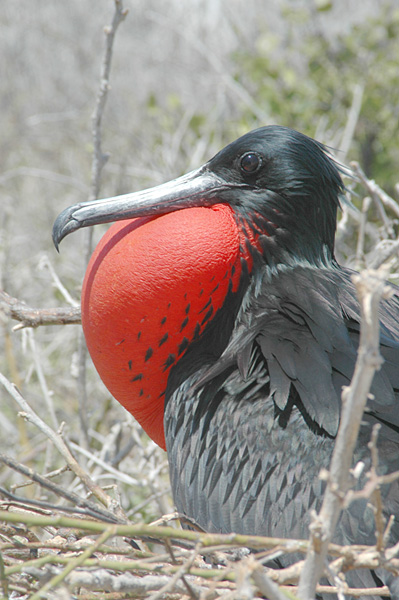Magnificent Frigatebird
Magnificent Frigatebirds are highly specialized seabirds, known for their aerial prowess and unique feeding habits. Unlike many other seabirds, they do not dive for fish. Instead, they catch their prey—typically fish and squid—near the surface of the water. They are also notorious kleptoparasites, meaning they often steal food from other birds. This behavior is facilitated by their incredible agility and speed in the air, which allows them to harass other birds, such as boobies or gulls, until they regurgitate their catch, which the frigatebirds then snatch mid-air.
Magnificent Frigatebird is truly magnificent

In St. Barth, the Magnificent Frigatebird is a familiar presence, often seen soaring high above the coastline or resting on the cliffs and islets that surround the island. The bird’s preference for nesting in remote locations helps protect it from many of the threats that other seabirds face, such as habitat destruction and human disturbance.
Magnificent Frigatebirds are also known for their remarkable breeding behavior. During the breeding season, which varies depending on the location, males gather in large colonies and inflate their red throat pouches while performing elaborate displays, including drumming their bills against the inflated sac and producing a distinctive warbling call. Females fly overhead, selecting mates based on the size and color of the gular sac, as well as the quality of the display.
Nesting occurs in large colonies, often on remote islands or inaccessible cliffs. The nests are rudimentary, made from sticks and other vegetation. The female lays a single egg, which both parents incubate. However, frigatebirds have a slow reproductive rate, with chicks taking several months to fledge and the parents often only breeding every other year.
The waters around St. Barth, part of the St. Barthélemy Natural Reserve, provide a rich feeding ground for these birds, supporting a healthy population of frigatebirds. Conservation efforts in the region focus on protecting these natural habitats, ensuring that the frigatebirds and other marine species can thrive in a relatively undisturbed environment.
For birdwatchers and nature enthusiasts visiting St. Barth, the Magnificent Frigatebird is a highlight of the island’s wildlife. Observing these birds in their natural habitat is a reminder of the island’s rich biodiversity and the importance of preserving it. Whether soaring above the ocean, engaged in courtship displays, or gliding effortlessly on the wind, the Magnificent Frigatebird embodies the wild, untamed spirit of the Caribbean.








